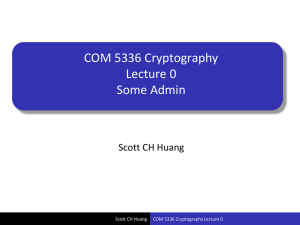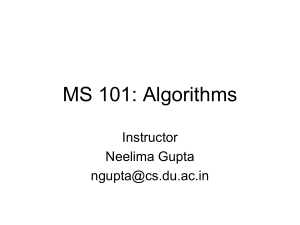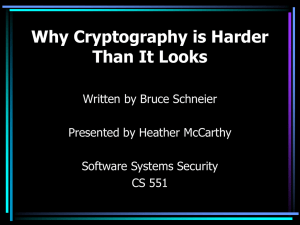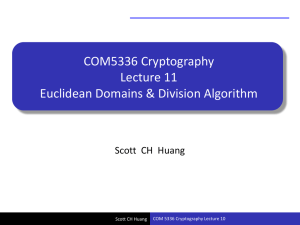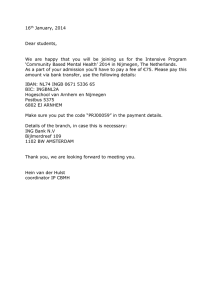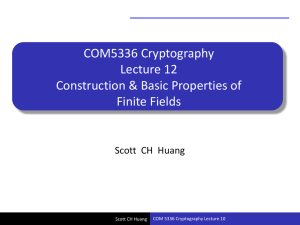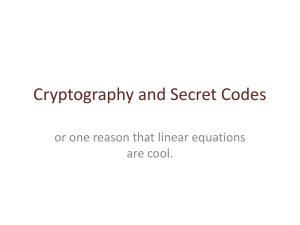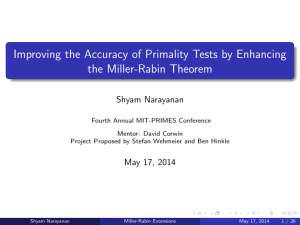Document
advertisement
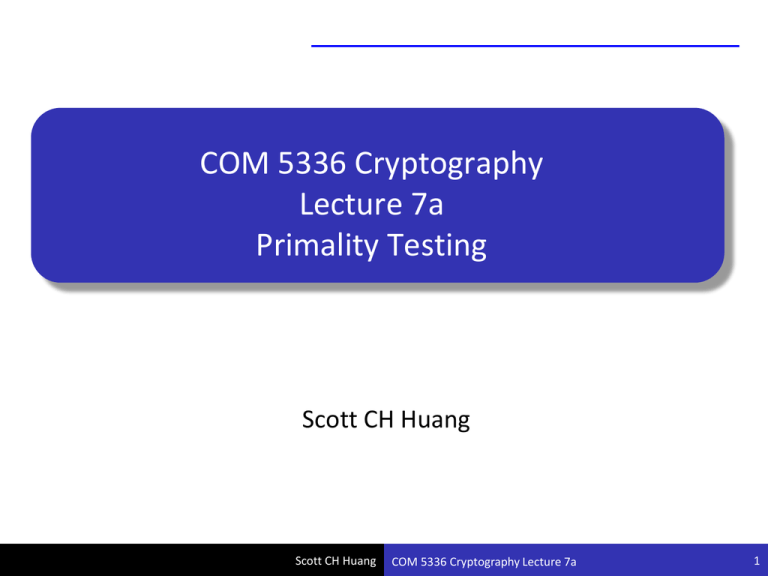
COM 5336 Cryptography
Lecture 7a
Primality Testing
Scott CH Huang
Scott CH Huang
COM 5336 Cryptography Lecture 7a
1
Definition
• A prime number is a positive integer p having exactly two
positive divisors, 1 and p.
• A composite number is a positive integer n > 1 which is
not prime.
Scott CH Huang
COM 5336 Cryptography Lecture 7a
Primality Test vs Factorization
• Factorization’s outputs are non-trivial divisors.
• Primality test’s output is binary: either PRIME or COMPOSITE
Scott CH Huang
COM 5336 Cryptography Lecture 7a
Naïve Primality Test
Input: Integer n > 2
Output: PRIME or COMPOSITE
for (i from 2 to n-1){
if (i divides n)
return COMPOSITE;
}
return PRIME;
Scott CH Huang
COM 5336 Cryptography Lecture 7a
Still Naïve Primality Test
Input/Output: same as the naïve test
for (i from 1 to
){
if (i divides n)
return COMPOSITE;
}
return PRIME;
Scott CH Huang
COM 5336 Cryptography Lecture 7a
Sieve of Eratosthenes
Input/Output: same as the naïve test
Let A be an arry of length n
Set all but the first element of A to TRUE
for (i from 2 to
){
if (A[i]=TRUE)
Set all multiples of i to FALSE
}
if (A[i]=TRUE) return PRIME
else return COMPOSITE
Scott CH Huang
COM 5336 Cryptography Lecture 7a
Primality Testing
Two categories of primality tests
• Probablistic
– Miller-Rabin Probabilistic Primality Test
– Cyclotomic Probabilistic Primality Test
– Elliptic Curve Probabilistic Primality Test
• Deterministic
– Miller-Rabin Deterministic Primality Test
– Cyclotomic Deterministic Primality Test
– Agrawal-Kayal-Saxena (AKS) Primality Test
Scott CH Huang
COM 5336 Cryptography Lecture 7a
Running Time of Primality Tests
• Miller-Rabin Primality Test
– Polynomial Time
• Cyclotomic Primality Test
– Exponential Time, but almost poly-time
• Elliptic Curve Primality Test
– Don’t know. Hard to Estimate, but looks like poly-time.
• AKS Primality Test
– Poly-time, but only asymptotically good.
Scott CH Huang
COM 5336 Cryptography Lecture 7a
Fermat’s Primality Test
• It’s more of a “compositeness test” than a primality test.
• Fermat’s Little Theorem:
If p is prime and
, then
• If we can find an a s.t.
, then n must be a composite.
• If, for some a, n passes the test, we cannot conclude n is
prime. Such n is a pseudoprime. If this pseudoprime n is not
prime, then this a is called a Fermat liar.
• If, for all
we have
can we conclude n is prime?
• No. Such n is called a Carmichael number.
Scott CH Huang
COM 5336 Cryptography Lecture 7a
Pseudocode of Fermat’s Primality Test
FERMAT(n,t){
INPUT: odd integer n ≥ 3, # of repetition t
OUTPUT: PRIME or COMPOSITE
for (i from 1 to t){
Choose a random integer a s.t. 2 ≤ a ≤ n-2
Compute
if (
) return COMPOSITE
}
return PRIME
}
Scott CH Huang
COM 5336 Cryptography Lecture 7a
Miller-Rabin Probabilistic Primality Test
• It’s more of a “compositeness test” than a primality test.
• It does not give proof that a number n is prime, it only tells us
that, with high probability, n is prime.
• It’s a randomized algorithm of Las Vegas type.
Scott CH Huang
COM 5336 Cryptography Lecture 7a
A Motivating Observation
FACT:
• Let p be an odd prime.
• Moreover, if
Let
or
. If
then
, and m is odd.
. Then either
for some
Scott CH Huang
COM 5336 Cryptography Lecture 7a
Miller-Rabin
• If
and
Then a is a strong witness for the compositeness of n.
• If
or
for some
then n is called a pseudoprime w.r.t. base a,
and a is called a strong liar.
Scott CH Huang
COM 5336 Cryptography Lecture 7a
Miller-Rabin: Algorithm Pseudocode
MILLER-RABIN(n,t){
INPUT: odd integer n ≥ 3, # of repetition t
Compute k & odd m s.t.
for ( i from 1 to t ){
Choose a random integer a s.t.
Compute
if (
or
){
Set
while(
and
){
Set
if (
) return COMPOSITE
}
if (
) return COMPOSITE
}
}
return PRIME
}
Scott CH Huang
COM 5336 Cryptography Lecture 7a
Miller-Rabin: Example
• n = 91
• 90 = 2*45, s = 1, r = 45
• {1,9,10,12,16,17,22,29,38,53,62,69,74, 75,79,81,82,90} are all strong liars.
– 945 = 1 mod 91
– 1045 = 1 mod 91
– ….
• All other bases are strong witnesses.
– 97 = 9 mod 91
– 98 = 81 mod 91
Scott CH Huang
COM 5336 Cryptography Lecture 7a
Miller-Rabin: Main Theorem
Theorem:
Given n > 9. Let B be the number of strong liars. Then
If the Generalized Riemann Hypothesis is true, then
Miller-Rabin primality test can be made deterministic by running
MILLER-RABIN(n, 2log2n)
Scott CH Huang
COM 5336 Cryptography Lecture 7a
